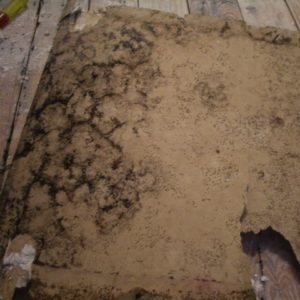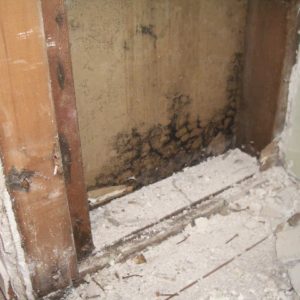Hello, I tore out some plaster today, and found some strange-looking substance on the back of the lathe boards. Pictures attached.
Anyone have thoughts on whether it’s black mold? If so, what precautions should I take? (I always wear a particle mask when doing demo).





















Replies
You got life insurance? Is it paid up?
You can buy a mold test kit at big box hardware stores. $11 at Ace Hardware or big box stores plus $30 for analysis and report.
I tested a similar-looking growth and amazingly enough the results came back as mushrooms!
have thoughts on whether it's black mold?
It certainly apprears to be a fungal growth that is black in color.
It does not appear to be the mold that Dr Blacke discovered, the one that gives off spore which causes a noxious histological reaction in persons exposed to it. You want full coverage and powered respiration when dealing with Blacke('s) mold.
Could be plebian mildew, too--not that insurance companies seem to make any distinction between deadly flora and everyday molds found under leaves and in grass and the like.
I am pretty layza faire (sp) about mold but my daughter was hyper sensitive to those molds that grow in wood piles in the woods and etc for about 3 formative years.
Some people dont do well with the common molds either. (she eats blue cheese like it is candy so some molds are nbd but others she had azmathatic (sp) reactions to.
1. Laissez-faire, literally: let do; i.e., allow to happen.2. asthmaticI minored in English.
Thanks Bill
I am a classic engineer. Got good enough grades on my verbals on SAT's to get to college and was thankful for that.
Got a lot better over the years in corporate america and because I read a lot but not good yet.
Learn something every day.
Thanks
I will work on remembering spelling of both!
Yes. It certainly appears to be mold. Avoid breathing it. Avoid disturbing it as much as possible. Try to remove the sheetrock in large pieces and take directly to the dumpster. Wear a respirator if you are going to be exposed to any significant airborne levels, or if you have a sensitivity to mold.
You don't need to test it. It matters little what color the mold is. Any mold in significant concentrations may affect a person.
Stachybotrys species are sometimes referred to by some as "black mold". We do not use the term. These molds are common environmental organisms. Certain species of mold, such as Stachybotrys species, are capable of producing chemicals called mycotoxins. While little is known about mycotoxins, research and case studies have suggested exposure to mycotoxins can cause human health effects.
Once cleaned or removed, it is imperative that the moisture source be eliminated, as continued moisture load could result in the redevelopment of mold.
Is mold similar to asbestos, in the sense that it does not pose a problem if sealed and left undisturbed? The water leak, if it still exists, originates in the bathroom and will be eliminated shortly. The space has hot water heat so there are no air ducts to worry about.I would prefer to leave it be if this is an option.
Thanks.
No, not really. Asbestos, if securely sealed and undisturbed, is truly the miracle mineral. It can't harm you unless you breath it or eat it. Molds can release toxins that could probably permeate a sheetrock enclosure. Depending on the sensitivity of an individual, that could negatively affect persons.Though I'm not overly concerned with mold, I would use some precautions and clean it before closing the wall. A bleach or Lysol solution should work, as long as you allow it to fully dry afterward.
Avoid the hysteria... all black mold is not the deadly black mold. Matter-of-fact, I think that very little of it is.
Furthermore, squirt a little bleach on it and the surrounding area with a spray bottle. It will kill it and its spores.
Otherwise, the spores are practically everywhere and any amount of moisture can bring them to life.
I refuse to accept that there are limitations to what we can accomplish. Pete Draganic
Edited 7/22/2008 1:07 pm ET by PeteDraganic
The term "black mold"is about as specific as "green vegetation"
Read up here: http://www.epa.gov/mold/
Remember Mary Dyer, a Christian Martyr (Thank you, Puritans)
http://en.wikipedia.org/wiki/Mary_Dyer
May your whole life become a response to the truth that you've always been loved, you are loved and you always will be loved" Rob Bell, Nooma, "Bullhorn"
Don't use bleach - it doesn't work. One chemical of choice is DBAC (Diethyl Benzyl Ammonium Chloride
http://www.traskresearch.com/mold.htm
Jeff
Edited 7/22/2008 11:44 pm ET by Jeff_Clarke
Check "greenbuilding.com" for a perspective on mold and removal. Also check your house, from roof to foundation, for water. Keep in mind ice dam, gutter, distance between siding material and ground, ground slope, etc. Hope this helps.